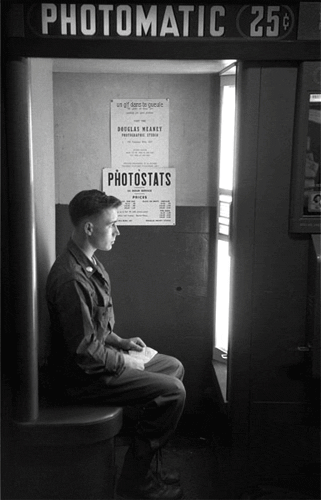
A camera caught in the act of stealing someone’s soul.
Via The Midnight Gallery

A camera caught in the act of stealing someone’s soul.
Via The Midnight Gallery
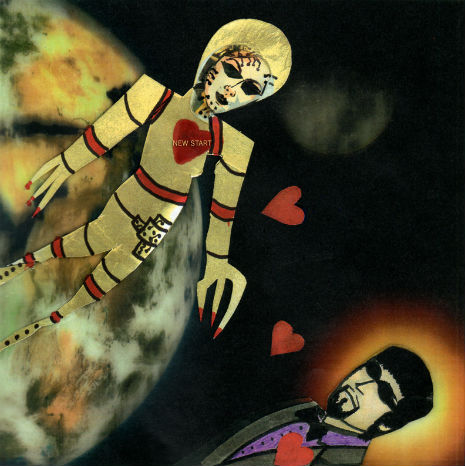
Dangerous Minds pal Otto von Ruggins (you may recall him as the keyboard player for the amazing mid-70s occult punk group Kongress or from his TV appearance with Ron Paul in the late 1980s) and intergalactic No Wave druid Von LMO (he was also in Kongress, and is considered a genius by no less of an authority than Julian Cope himself) have returned with their new group Avant Duel:
“Avant Duel displays a multiplicitude of realities where cognitive dissonance rules and there are NO RULES!”
Avant Duel recently played live at the Max’s Kansas City Reunion at The Bowery Electric where Von LMO chopped into his guitar with a meat cleaver and just kept right on playing.
Here’s a link to their Bandcamp page
Follow Avant Duel on Facebook
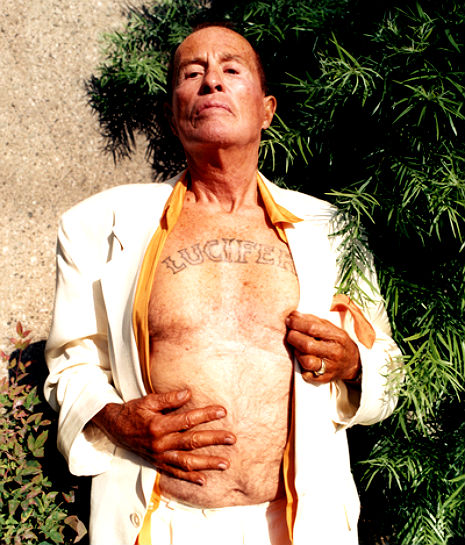
As a film, Anger Me is almost the antithesis of a Kenneth Anger film . It’s about as artful as an industrial training movie. But it does feature one of the great visionaries of cinema speaking to a camera for 70 minutes and for fans and admirers of Kenneth Anger, that is something to be grateful for. This is a talking head well-worth listening to.
Director Elio Gelmini clearly believes that Anger can carry the film on his own and given Anger’s fascinating history and storytelling gifts the film succeeds despite its threadbare production. The film would have greatly benefited from a more expansive approach. As Anger discusses his work, scenes from his films have been added to a blue screen background and the effect diminishes the evocative mystery of Anger’s imagery. You yearn to enter the mystical caverns of Anger’s world, but instead are left with a kind of retro MTV effect. Ironic, considering Anger hugely influenced the world of music videos, pointing a direction away from glossiness into something more magical and dreamlike. But putting aside my criticism of the film’s technique, I applaud Gelmini for shining a light on one of the most remarkable human beings to have had an impact on my life.
So here have it, Anger Me. For those unfamiliar with Kenneth Anger, this is a solid introduction. Watch it and then seek out his work on DVD. It’s mindblowing stuff.

This week marks the 60th anniversary of the death of rocket scientist and occultist John Whiteside “Jack” Parsons. In addition to being a pioneer in the filed of rocketry—at the age of 25, Parson was part of the first US Government’s first official rocket group. He later invented the formulation of the solid rocket fuel that eventually put man on the moon—Parsons was a follower of Aleister Crowley, a one-time associate of Scientology founder L. Ron Hubbard and a self-proclaimed Antichrist.
From the bio on the Cameron-Parsons Foundation’s website:
MARVEL WHITESIDE PARSONS, always know as Jack, was born October 2, 1914 in Los Angeles, California. A chemical engineer and explosives expert, he was a principal scientist in the experimental rocket research group attached to the California Institute of Technology during the 1930’s. Their testing range in the area of Devil’s Gate Dam above Pasadena has since grown to become the Jet Propulsion Laboratory; Parsons was also a co-founder of the Aerojet General Corporation.
Together with his first wife, Helen Parsons Smith, Parsons joined the Ordo Templi Orientis (O.T.O.) in 1941, the same year as his most successful scientific achievement, Jet Assisted Take-Off (JATO). He was very much the young lion of the occult Order and, under the tutelage of Aleister Crowley, briefly served as the acting master of Agape Lodge. His now famous invocation, “The Babalon Working,” was first performed in 1946, with former WAVE Marjorie Cameron serving as Scarlett Woman and L. Ron Hubbard, future founder of the Church of Scientology, channeling words from the ether as Scribe while Jack performed as Priest.
The “Working” reset the course of Parsons’ life, ending his relationship with Aleister Crowley and the O.T.O. In his surviving essays and polemical writings, Parsons anticipated by many years the ethical, moral, religious and social dilemmas of the future.
Parsons died in an explosion of mysterious origin at his chemical laboratory at home in Pasadena on June 17, 1952. His second wife and collaborator, the artist Cameron, preserved and carried on his work until her death in 1995. In 1972 the International Astronomical Union named a crater on the moon (37°N 171°W) after Parsons in recognition of his pivotal role in developing the solid fuel rocket.
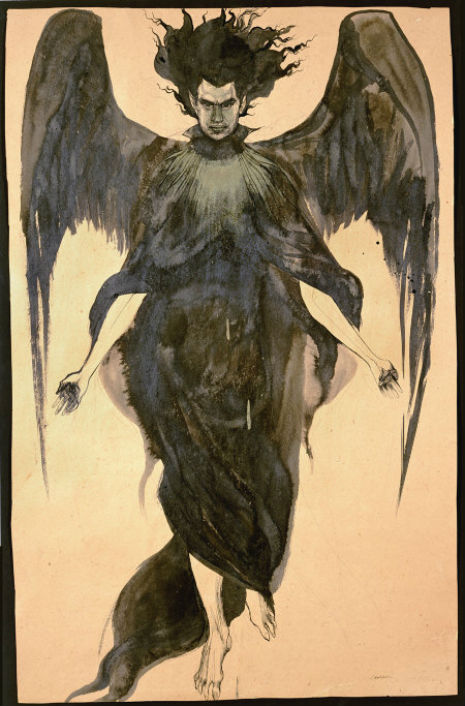
Painting of Jack Parsons by his widow, Marjorie Cameron
Additional reading:
Rocket Man by Scott Hobbes
The Crying of Liber 49: Jack Parsons, Antichrist Superstar (From my Book of Lies anthology)
More film footage of Jack Parsons after the jump
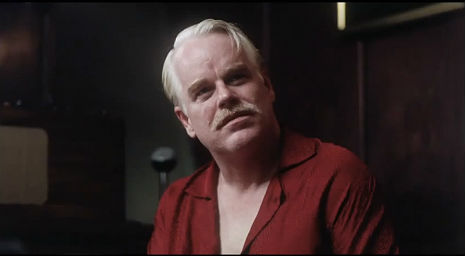
The marketing campaign for director Paul Thomas Anderson’s fictionalized L.Ron Hubbard flick, The Master, is starting to heat up. Yesterday a mysterious trailer with Philip Seymour Hoffman, Amy Adams and Joaquin Phoenix was released and it looks like this is going to be a fascinating film.
Here’s all it says on IMDB at present:
“A 1950s-set drama centered on the relationship between a charismatic intellectual known as “the Master” whose faith-based organization begins to catch on in America, and a young drifter who becomes his right-hand man.”
Hoffman as Hubbard is an inspired bit of casting (although I think the ultimate portrayal of Hubbard will come one day from The Mighty Boosh‘s Rich Fulcher) but are Adams and Phoenix supposed to be based on Marjorie Cameron and Jack Parsons? It kinda looks that way.
One of the film’s producer, JoAnne Sellar, denied any connection to Hubbard or Scientology: “It’s a World War II drama. It’s about a drifter after World War II.”
Yeah, right…
With a tense soundtrack from Radiohead’s Jonny Greenwood. The Master is scheduled for release on “Crowleymass,” October 12th. I wonder if that is a co-incidence or deliberate?

Terence McKenna at his house in Hawaii by Dean Chamberlain
Renowned science writer John Horgan, author of The End of Science, Rational Mysticism and several other books, pens a regular column at Scientific American where he takes a closer look at some of the quirkier topics that can still fall under the purview of “Science.” His current column pertains to Terence McKenna, the late psychedelic bard who spoke of the “self-transforming machine elves from hyperspace” he’d meet though psychedelic drug use.
What interests Horgan the most pertains to McKenna’s so-called Timewave Zero theory of history, which holds that something “novel” and mind-bending would happen on December 21, 2012. This notion was “revealed” to him by an “alien intelligence” during a psychedelic experiment conducted by McKenna and his younger brother Dennis, in the Amazon jungle in 1971 (Dennis McKenna, today a respected ethnopharmacologist, was the “channel” through which this entity supposedly spoke, has apparently never been much of a believer in his brother’s apocalyptic theories).
The Timewave Zero formula purports to mathematically “decode” the 64 hexagrams of the King Wen sequence of the I Ching into something that graphs fractal patterns of “novelty” and particularly active eras in history, culminating in a singularity point of infinite complexity that he predicted would happen at the end of the 13th b’ak’tun of the Maya calendar.
McKenna believed that all of human history and cultural and scientific evolution were moving inexorably towards a “strange attractor” at the end of time. Timewave Zero was later codified into a software program that seemingly mapped major moments in humanity’s evolution with the Timewave’s peaks and valleys.
McKenna’s theory, as written about at length in his books The Invisible Landscape and True Hallucinations, is a fascinating hermeneutic intellectual construction, and one that allowed for him to spin poetic and truly mind-bending thoughts about history, man’s place in the cosmos and of course, a sort of psychedelically-constructed apocalypticism that kept audiences absolutely spellbound, but rationally speaking, it’s wild-eyed, tied-dyed nonsense for soft-brained people…
John Horgan went to hear McKenna speak at a 1999 talk in Manhattan sponsored by the Open Center (I was in attendance at the talk myself, more on this below) and interviewed the psychedelic spokesman the following day. The object of Horgan’s line of inquiry was, not so surprisingly, to ask McKenna if he was actually serious about his 2012 predictions:
So what did McKenna really think would happen on December 21, 2012? “If you really understand what I’m saying,” he replied, “you would understand it can’t be said. It’s a prediction of an unpredictable event.” The event will be “some enormously reality-rearranging thing.” Scientists will invent a truly intelligent computer, or a time-travel machine. Perhaps we will be visited by an alien spaceship, or an asteroid. “I don’t know if it’s built into the laws of spacetime, or it’s generated out of human inventiveness, or whether it’s a mile and a half wide and arrives unexpectedly in the center of North America.”
But did he really think the apocalypse would arrive on December 21, 2012? “Well…” McKenna hesitated. “No.” He had merely created one mathematical model of the flow and ebb of novelty in history. “It’s a weak case, because history is not a mathematically defined entity,” he said. His model was “just a kind of fantasizing within a certain kind of vocabulary.” McKenna still believed in the legitimacy of his project, even if his particular model turned out to be a failure. “I’m trying to redeem history, make it make sense, show that it obeys laws,” he said.
But he couldn’t stop there. His eyes glittering, he divulged a “huge–quote unquote—coincidence” involving his prophecy. After he made his prediction that the apocalypse would occur on December 21, 2012, he learned that thousands of years ago Mayan astronomers had predicted the world would end on the very same day. “And now there has been new scholarship that they were tracking the galactic center and its precessional path through the ecliptic plane. What does all this mean?” McKenna leaned toward me, his eyes slitted and his teeth bared. “It means we are trapped in software written by the ghost of Jorge Luis Borges!” He threw his head back and cackled. “Tell that to the National Academy of Sciences!”
McKenna, when pressed said to Horgan, “I’m Irish! What’s your excuse!”
Although I have listened to (literally) hundreds of hours of his recorded talks, attended many, many speeches and even a weekend-long seminar (incongruously held on the outdoor “western village” set of Dr. Quinn, Medicine Woman) I can’t claim that I really knew Terence McKenna all that well, but I was most certainly acquainted with him and, in fact, was due to take him over the bridge to meet Howard Bloom in Brooklyn (Bloom was bedridden at the time) later in the very same day that Horgan interviewed him (McKenna cancelled because he was feeling tired; two weeks later he would have seizures and be diagnosed with inoperable brain cancer).
I’ve written before of how Timothy Leary expressed extreme exasperation about McKenna’s theories (In 1996 Leary shouted at me as I tried to defend him, that “Terence McKenna is a High Episcopalian!”) and how coldly dismissive Robert Anton Wilson was of his ideas (Bob would just roll his eyes and shake his head whenever the topic of Terence or 2012 came up). My take on the whole Timewave Zero/2012 thing and whether or not he truly believed it or not, is that “No,” I do not think that Terence McKenna wholeheartedly believed in his own psychedelic blarney. I think that he DID believe it at one time, but from personal observations on several occasions throughout the 1990s, when I would see him after one of his talks and observe his interaction with others, I don’t think this belief stayed with him.
To be perfectly honest, he often felt downright cynical to me when he discussed the Timewave Zero theory because it seemed like he knew he was spouting bullshit and it caused him to be curt, even disrespectful at times, to some of the people—especially the New Age true believer-types—who were in attendance at his talks.
Granted I might have only been around McKenna when he was feeling grumpy or wasn’t up for playing his expected role as a “guru” that day, but this is what I saw with my own eyes.
Thank you Steven Otero!
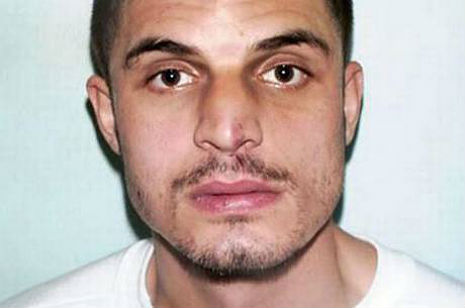
Reefer Madness—not so ridiculous after all?
Another month, another PCP face-eating incident – it’s difficult to imagine this particular drug ever wholly shedding its unfortunate association with spontaneous cannibalism.
All such occurrences recall to me a curious chat I once had with an engaging crank who claimed disembodied and malevolent spirits liked to haunt pubs and bars, as sufficiently inebriated souls (if sufficiently weak-minded) were easy to “hitch a ride with” – hence the middling mayhem that forever orbits serious boozing.
Accordingly, might we posit that PCP can open channels to some very unpleasant (not to mention peckish) entities indeed?
If you keep an eye out for these incidents, you might also observe that some of the other, generally better-regarded recreational drugs appear to induce comparable states of spiritual vulnerability. To my mind, one of the most illustrative (not to mention blackly comic) examples of this phenomenon took place in 2004, when the then 24-year-old Daniel Gonzales – aka “Zippy” aka “The Freddy Krueger Killer” and the “Mummy’s Boy Killer”– ended up going on a four day knife-wielding killing spree around Sussex and North London after a night’s raving – killing four and attacking two others.
An insight into the singularly bizarre turn of Zippy’s mind was provided when an old friend of his sold their correspondence (conducted after Zippy was convicted and locked up in a maximum security psychiatric institution) to an English tabloid. In this correspondence, Zippy comes across as a truly ungodly mixture of Ali G and Jack the Ripper. Generally buoyant – “Bruv, it’s Zippy, your favourite serial killer!” – but forever pining for his beloved Ketamine and Doomcore (a fast, particularly unpleasant form of techno), the least effort at introspection reduces Zippy to a state of bewildered incoherence.
“Did you read my story in da paper? Enuff of dat cos it’s doin my head in, I just wanted to be like the guy in Scream or Halloween nuffin wrong wiv dat iz there? Wouldn’t you wanna be like Mike Meyers? But it ain’t worth it. U ’ave to pay the price.”
Deep. But however hard our “favourite serial killer” on occasion tries to meditate upon his actions (“I done somefin sick + I can’t believe it”), Zippy’s thoughts tend more towards raving than redemption:
“I know you will still be partying when I get out so we can go to Amsterdam together and all that. I won’t be in here forever so not to worry – as long as you stay goin partys and snortin K.”
You’ve got to admire Zippy’s conviction that, in the extraordinarily unlikely eventuality of his release (Zippy’s judge recommended he be incarcerated indefinitely – and poor Zippy actually died in custody in 2007), his old pals would be so keen to pick up where they left off – skipping over to the ’dam to feast on psychedelics with a geriatric serial killer. Certainly Zippy’s “eccentricities” were generously tolerated prior to his arrest, as the following vignette (offered by Zippy’s correspondent in the accompanying tabloid interview) vividly demonstrates:
“Only a year before the murders we were round a friend’s house when Zippy pulled a map out of his pocket and unfolded it. He’d marked several churches in red ink and also named vicars serving at each. Someone asked what it was and he said he was studying it because he planned to kill all of the vicars in one, long rampage. Everyone just burst out laughing.”
A retrospectively sinister moment, you imagine! And one that arguably fits the hypothesis of possession – as might the following account of the killings themselves. Walk us through it, Zip, how did it all come to pass?
“Well I guess u wanna no wot happened! Remember that party wot we went to, it all happened after that party. I went out + killed 4 people cos I was so bored, basically I don’t know why I done it.”
So it would seem. At the time, the tabloids launched a half-baked witch hunt for Doomcore, but quickly lost interest after establishing that Zippy was one of about seven people who actually liked it. You’d think they’d have gone after recreational drugs (or even slasher films) instead. But, possession theory aside, I would recommend steering clear of anyone whose ideal night in consists of Doomcore, Freddy Kruger, and a gram of Ketamine. And whatever you do, don’t give them any PCP.

Dean Chamberlain’s famous portrait of Tim Leary
Jim Bliss writes at Dorian Cope’s On This Deity blog:
At 12:44am on the 31st of May 1996, Dr. Timothy Leary sat bolt upright in bed startling the small group of friends and family who had gathered to keep him company during his final days. He had been diagnosed with inoperable prostate cancer the previous year and it had finally run its course. “Why not?” he asked those keeping vigil. Again, louder, “Why not?” He repeated the question a third time. “Why not?” Then, lying back down, Dr. Leary whispered his final word… “beautiful”… and slipped into death. He was 75 years old.
It’s hard to think of many public figures who split opinion to the degree that Leary did, and still does. Hailed by some as one of the most important philosophers of his generation, by others as a visionary scientist centuries ahead of his time, and by some as a prophet, a mystic, a guru, even a saint. While still others denounce him as a fool, an ego-maniacal charlatan and even – in the words of President Richard Nixon – “the most dangerous man in America”. As is so often the case, the truth is far more complex than the simple narratives produced by those who worshipped or abhorred him. In fact Leary’s life and work encapsulate perfectly the chaos and ambiguity; the heady highs and crashing lows; of the psychedelic counter-culture he – more than any other single individual – helped to create.
Read more at On This Deity

Here’s the back story of the famous William Burroughs/Jimmy Page Crawdaddy magazine cover story of June 1975, excerpted from LZ-‘75: The Lost Chronicles of Led Zeppelin’s 1975 American Tour by Stephen Davis. Read the original article, “Rock Magic: Jimmy Page, Led Zeppelin and a search for the elusive Stairway to Heaven” by William Burroughs here.
The long black limousine carrying Jimmy Page to his encounter with William Burroughs made its way down Fifth Avenue in a light snowfall. The car stopped in front of 77 Franklin Street in a dark, shabby neighborhood of vacant or abandoned industrial lofts that were slowly being reclaimed by young artists and urban pioneers. Jimmy was greeted at street level by James Grauerholz, Burroughs’s young assistant, who led Page up four steep flights of stairs to Burroughs’s loft. The sixty-one- year-old writer, dressed in a coat and tie set off by an embroidered Moroccan vest, extended his hand and offered his guest a cup of tea, which Page happily accepted. Also on hand was a photographer to document the interview, and Crawdaddy’s publisher, Josh Feigenbaum, whose idea this meeting had been. Before getting down to business, Burroughs proudly showed Page his orgone accumulator, which looked like a big plywood crate. Sitting in this box, Burroughs explained, concentrated certain energies in a productive and healthful manner according to theories developed by the psychiatrist Wilhelm Reich. Jimmy Page declined Burroughs’s offer to give the orgone box a try.
Burroughs thought he and Jimmy might know people in common since Burroughs had lived in London for most of the past ten years. It turned out to be an interesting list, including film director Donald Camell, who worked on the great Performance; John Michell, an expert on occult matters, especially Stonehenge and UFOs; Mick Jagger and other British rock stars; and Kenneth Anger, auteur of Lucifer Rising. Burroughs told Page about the feelings of energy and exhilaration he experienced sitting in the thirteenth row of a Led Zeppelin concert. These feelings, he told Page, were similar to those he had known while listening to music in Morocco, especially the loud pipes and drums of the Master Musicians of Jajouka. Page somewhat sheepishly admitted that he had yet to visit Morocco but had been to India and Thailand and heard a lot of music there.
Burroughs was interested in getting Page to speak about crowd control, a longtime fascination. “It seems to be that rock stars are juggling fissionable material of the mass unconscious that could blow up at any time,” he pondered.
“You know, Jimmy,” he continued. “The crowd surges forward . . . a heavy piece of equipment falls on the crowd . . . security goes mad, and then . . . a sound like goddamned falling mountains or something.”
Page didn’t bat an eye. “Yes, I’ve thought about that. We all have. The important thing is to maintain a balance. The kids come to get as far out with the music as possible. It’s our job to see that they have a good time and no trouble.”
Burroughs launched into a series of morbid anecdotes he’d collected about fatal crowd stampedes, like the 360 soccer fans crushed to death during a riot in Lima, Peru. Then there was the rock band Storm playing a dance hall in Switzerland. Their pyro effects exploded, but the fire exits had been chained shut. “Thirty-seven people dead, including all the performers,” Burroughs recalled.
He poured two fingers of whiskey for himself and for Page. Burroughs had been informed that these were the first Zeppelin shows to deploy any special effects. “Sure,” Page said. “That’s true. Lights, lasers, dry ice are fine. But I think, again, that you have to have some balance. The show must carry itself and not rely too heavily on special effects, however spectacular. What I really want is laser . . . notes. That’s more what I’m after. Just . . . cut right through!”
Burroughs then wondered if the power of mass concentration experienced by Zeppelin’s audience could be transposed into a kind of magic energy that could materialize an actual stairway to heaven. He added that the moment when the stair- way becomes something physically possible for the audience could be the moment of greatest danger. Page again answered that a performer’s skill involved avoiding these dangers. “You have to be careful [with large audiences],” he said. “It’s rather like driving a load of nitroglycerine.” Page described the fan abuse they had seen in Philadelphia a few days earlier as an ex- ample of a situation that could really crack, but somehow didn’t.
Over margaritas at the nearby Mexican Gardens restaurant, Burroughs asked about Page’s house on the shores of Loch Ness in Scotland, which had once belonged to Aleister Crowley. Was it really haunted? Page said he was sure it was. Does the Loch Ness monster exist? Page said he thought it did. Skeptical, Burroughs wondered how the monster could get enough to eat. The conversation continued over enchiladas. Burroughs talked about infrasound, pitched below the level of human hearing, which had supposedly been developed as a weapon by the French military. Then on to interspecies communication, talking to dolphins via sonar waves. Burroughs said he thought a remarkable synthesis could be achieved if rock music returned to its ancient roots in ceremony and folklore, and brought in some of the trance music one heard in Morocco.
Jimmy Page was receptive. “Well, music which involves [repeating] riffs, anyway, will have a trancelike effect, and it’s really like a mantra. And, you know, we’ve been attacked for that.”
They parted company on the icy sidewalk outside the restaurant, with many thanks and good-byes. Jimmy Page’s limo, which had been waiting for him, whisked him back to the Plaza Hotel. William Burroughs, James Grauerholz, and Josh Feigenbaum walked back to Burroughs’s loft to listen to the tape that Josh had recorded of the conversation.
Speaking of Jimmy Page and magick, here’s the maestro’s seldom-heard abandoned score for Kenneth Anger’s Lucifer Rising: Part II is here.

Not as sensationalist as its title, The Beach Boys and Satan is actually a pretty good documentary on the The Beach Boys, and Brian Wilson in particular.
Made by a German film crew in 1997 as part of the Pop Odyssee TV series, The Beach Boys and Satan includes interviews with Kenneth Anger, Kim Fowley, Dick Dale and members of The Beach Boys. It covers some familiar ground, including the Charles Manson connection, while still managing to offer a few new insights. Well worth a watch for the archival footage, Kim Fowley’s brief performance of “1965” and interviews with Brian Wilson.